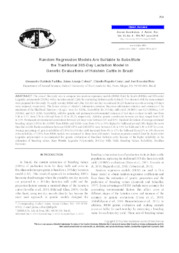Random regression models are suitable to substitute the traditional 305-day lactation model in genetic evaluations of holstein cattle in Brazil.
Random regression models are suitable to substitute the traditional 305-day lactation model in genetic evaluations of holstein cattle in Brazil.
Autoria: PADILHA, A. H.; COBUCI, J.; COSTA, C. N.; BRACCINI NETO, J.
Resumo: The aim of this study was to compare two random regression models (RRM) fitted by fourth (RRM4) and fifth-order Legendre polynomials (RRM5) with a lactation model (LM) for evaluating Holstein cattle in Brazil. Two datasets with the same animals were prepared for this study. To apply test-day RRM and LMs, 262,426 test day records and 30,228 lactation records covering 305 days were prepared, respectively. The lowest values of Akaike?s information criterion, Bayesian information criterion, and estimates of the maximum of the likelihood function (?2LogL) were for RRM4. Heritability for 305-day milk yield (305MY) was 0.23 (RRM4), 0.24 (RRM5), and 0.21 (LM). Heritability, additive genetic and permanent environmental variances of test days on days in milk was from 0.16 to 0.27, from 3.76 to 6.88 and from 11.12 to 20.21, respectively. Additive genetic correlations between test days ranged from 0.20 to 0.99. Permanent environmental correlations between test days were between 0.07 and 0.99. Standard deviations of average estimated breeding values (EBVs) for 305MY from RRM4 and RRM5 were from 11% to 30% higher for bulls and around 28% higher for cows than that in LM. Rank correlations between RRM EBVs and LM EBVs were between 0.86 to 0.96 for bulls and 0.80 to 0.87 for cows. Average percentage of gain in reliability of EBVs for 305-day yield increased from 4% to 17% for bulls and from 23% to 24% for cows when reliability of EBVs from RRM models was compared to those from LM model. Random regression model fitted by fourth order Legendre polynomials is recommended for genetic evaluations of Brazilian Holstein cattle because of the higher reliability in the estimation of breeding values.
Ano de publicação: 2015
Tipo de publicação: Artigo de periódico
Unidade: Embrapa Gado de Leite
Palavras-chave: 305-Day Milk Yield, Brazilian Holstein, Breeding Values, Legendre Polynomials
Observações
1 - Por padrão são exibidas publicações dos últimos 20 anos. Para encontrar publicações mais antigas, configure o filtro ano de publicação, colocando o ano a partir do qual você deseja encontrar publicações. O filtro está na coluna da esquerda na busca acima.
2 - Para ler algumas publicações da Embrapa (apenas as que estão em formato ePub), é necessário ter, no celular ou computador, um desses softwares gratuitos. Sistemas Android: Google Play Livros; IOS: iBooks; Windows e Linux: software Calibre.
Acesse outras publicações
Acesse a Base de Dados da Pesquisa Agropecuária (BDPA) para consultar o acervo completo das bibliotecas da Embrapa.

